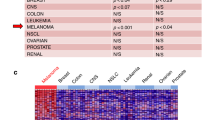Summary
Two human melanoma xenografts were compared with respect to their in vivo growth and metastatic potentials as well as glycosaminoglycan patterns. The less differentiated HT 168 tumor showed faster growth at primary sites and a more pronounced capacity for metastasis into the liver. Although chondroitin sulfate was the dominant glycosaminoglycan subtype in both tumors, the more invasive xenograft had a higher heparan sulfate/chondroitin sulfate (HS/CS) ratio. We suggest that tumor progression is influenced by this ratio in this human melanoma system.
Similar content being viewed by others
References
Barbera-Guillem E, Barcelo JR, Urcelay B, Alonso-Varona AI (1988) Noncorrelation between implantation and growth of tumor cells for their final metastatic efficiency. Invasion Metastasis 8:266–284
Bitter T, Muir HM (1962) A modification of uronic acid carbazole reaction. Anal Biochem 4:330–334
Bomirski A, Slominski A, Bigda J (1988) The natural history of a family of transplantable melanomas in hamsters. Cancer Metastasis Rev 7:95–118
Bumol TF, Walker LE, Reisfeld RA (1984) Biosynthetic studies of proteoglycans in human melanoma cells with a monoclonal antibody to a core glycoprotein of chondroitin sulfate proteoglycans. J Biol Chem 259:2733–2741
Delcroix M, Libert A, Lejeune F (1986) Identification of fibroblastoid cell type in human melanoma cultures. J Natl Cancer Inst 77:1171
Doré J-F, Bailly M, Bertrand S (1987) Metastases of human tumors in experimental animals. Anticancer Res 7:997–1004
Esko JD, Rostand KS, Weinke JL (1988) Tumor formation dependent on proteoglycan biosynthesis. Science 241:1092–1096
Fidler IJ (1986) Rationale and methods for the use of nude mice to study the biology and therapy of human cancer metastasis. Cancer Metastasis Rev 5:29–49
Ganderup GF, Newburger AE, McCullogh JL (1986) Growth kinetics of primary versus metastatic human melanoma xenografts in nude mice. J Invest Dermatol 87:537–539
Iozzo RV (1988) Proteoglycans and neoplasia. Cancer Metastasis Rev 7:39–50
Kerbel RS, Man MS, Dexter D (1984) A model of human cancer metastasis: extensive spontaneous and artificial metastasis of human pigmented melanoma and derived variant sublines in nude mice. J Natl Cancer Inst 72:93–108
Kopper L, Steel GG (1975) The therapeutic response of three humman tumor lines maintained in immunosuppressed mice. Cancer Res 35:2704–2713
Kopper L, Hanh TV, Lapis K (1982) Experimental model for liver metastasis formation using Lewis lung tumor. J Cancer Res Clin Oncol 103:31–38
Lapis K, Timár J, Pál K, Kopper L, Jeney A, Timár F (1987) Membrane properties of Lewis lung tumor lines with “low” and “high” metastatic capacity. Selective antimetastatic effect of a new glycoconjugate-glycosaminoglycan blocking agent 5′-hexyl-2′-deoxyuridine (HUdR). In: Cory JG, Szentiványi A (eds) Cancer biology and therapeutics. Plenum, pp 79–94
Liotta LA (1986) Tumor invasion and metastasis-role of the extracellular matrix. Cancer Res 46:1–7
Maniglia CA, Gomez JJ, Luikart SD, Sartorelli AC (1985) Glycosaminoglycan production and distribution in cloned B16 murine melanoma cell lines exhibiting different lung colony forming efficiences. J Natl Canc Inst 75:111–120
Montreuil J (1984) Spatial conformation of glycans and glycoproteins. Biol Cell 51:115–132
Nicolson GL (1987) Tumor cell instability, diversification and progression to the metastatic phenotype: from oncogene to oncofetal expression. Cancer Res 47:1473–1487
Redini F, Verrelle P, Hillova J, Poupon MF, Moczar E (1987) Cell surface glycosaminoglycans of tumor cell line and its DNA transfected variant differing in their lung colonization potential. Glycoconjugate J 4:191–201
Retting WJ, Real FX, Spengler BA, Biedler JL, Old LJ (1986) Human melanoma proteoglycan; expression in hybrids controlled by intrinsic and extrinsic signals. Science 231:1281–1284
Schwarz-Albiez R, Steffen I, Lison A, Güttler N, Schirrmacher V, Keller R (1988) Expression and enhanced secretion of proteochondroitin sulfate in a metastatic variant of a mouse lymphoma cell line. Br J Cancer 57:569–575
Sevier AC, Munger BL (1965) A silver method for paraffin sections of neural tissue. J Neuropathol Exp Neurol 24:130–135
Steck PA, Cheong PH, Nakajima M, Yung VKA, Moser RP, Nicolson GL (1987) Altered expression of glycosaminoglycans in metastatic 13762NF rat mammary adenocarcinoma cells Biochemistry 26:1020–1028
Timár J, Moczar E, Timár F, Pál K, Kopper L, Lapis K, Jeney A (1987) Comparative study on Lewis lung tumor lines with “low” and “high” metastatic capacity: II. Cytochemical and biochemical evidence for differences in glycosaminoglycans. Clin Exp Metastasis 5:79–87
Turley EA, Tretiak M (1986) Glycosaminoglycan production of murine melanoma variants in vivo and in vitro. Cancer Res 54:5098–5105
Author information
Authors and Affiliations
Rights and permissions
About this article
Cite this article
Timár, J., Kovalszky, I., Paku, S. et al. Two human melanoma xenografts with different metastatic capacity and glycosaminoglycan pattern. J Cancer Res Clin Oncol 115, 554–557 (1989). https://doi.org/10.1007/BF00391357
Received:
Accepted:
Issue Date:
DOI: https://doi.org/10.1007/BF00391357




